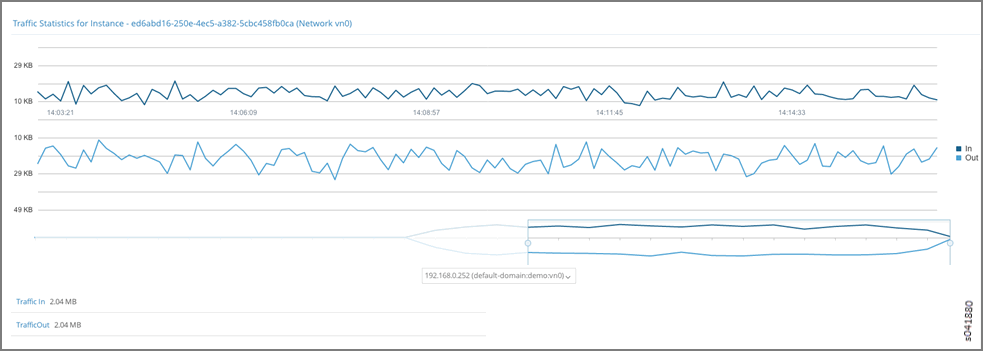Example: Debugging Connectivity Using Monitoring for Troubleshooting
Using Monitoring to Debug Connectivity
This example shows how you can use monitoring to debug connectivity in your Contrail system. You can use the demo setup in Contrail to use these steps on your own.
- Navigate to Monitor -> Networking -> Networks ->
default-domain:demo:vn0, Instanceed6abd16-250e-4ec5-a382-5cbc458fb0cawith IP address192.168.0.252in the virtual networkvn0. See Figure 1.Figure 1: Navigate to Instance
- Click the instance to view Traffic Statistics for
Instance. See Figure 2.Figure 2: Traffic Statistics for Instance

- Instance
d26c0b31-c795-400e-b8be-4d3e6de77dcfwith IP address192.168.0.253in the virtual networkvn16. See Figure 3 and Figure 4.Figure 3: Navigate to Instance Figure 4: Traffic Statistics for Instance
Figure 4: Traffic Statistics for Instance
- From Monitor->Infrastructure->Virtual Routers->a3s18->Interfaces, we can see that Instance
ed6abd16-250e-4ec5-a382-5cbc458fb0cais hosted on Virtual Routera3s18. See Figure 5.Figure 5: Navigate to a3s18 Interfaces
- From Monitor->Infrastructure->Virtual Routers->a3s19->Interfaces, we can see that Instance
d26c0b31-c795-400e-b8be-4d3e6de77dcfis hosted on Virtual Routera3s19. See Figure 6.Figure 6: Navigate to a3s19 Interfaces
- Virtual Routers
a3s18anda3s19have the ACL entries to allow connectivity betweendefault-domain:demo:vn0anddefault-domain:demo:vn16networks. See Figure 7 and Figure 8.Figure 7: ACL Connectivity a3s18 Figure 8: ACL Connectivity a3s19
Figure 8: ACL Connectivity a3s19
- Next, verify the routes on the control node for routing
instances
default-domain:demo:vn0:vn0anddefault-domain:demo:vn16:vn16. See Figure 9 and Figure 10.Figure 9: Routes default-domain:demo:vn0:vn0 Figure 10: Routes default-domain:demo:vn16:vn16
Figure 10: Routes default-domain:demo:vn16:vn16
- We can see that VRF
default-domain:demo:vn0:vn0on Virtual Routera3s18has the appropriate route and next hop to reach VRFdefault-domain:demo:front-endon Virtual Routera3s19. See Figure 11.Figure 11: Verify Route and Next Hop a3s18
- We can see that VRF
default-domain:demo:vn16:vn16on Virtual Routera3s19has the appropriate route and next hop to reach VRFdefault-domain:demo:vn0:vn0on Virtual Routera3s18. See Figure 12.Figure 12: Verify Route and Next Hop a3s19
- Finally, flows between instances (IPs
192.168.0.252and192.168.16.253) can be verified on Virtual Routersa3s18anda3s19. See Figure 13 and Figure 14.Figure 13: Flows for a3s18 Figure 14: Flows for a3s19
Figure 14: Flows for a3s19
